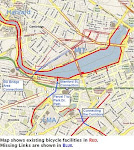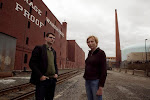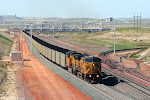
Following the recent MBTA Green Line crash at Government Center, and with another similar crash in recent history on the Riverside Line, a number of people have asked “Can it have been prevented?” In other words, could a more modern type of signals and train control have made it impossible for one train to crash into another?
Right now there are signals in the subway and out on the Riverside Line. But, unlike other lines, there is no “enforcement” of the signals. On the other subway lines and on major rail lines (like Amtrak’s Northeaster Corridor), a train that passes a red light will automatically have its breaks come on.
There is no such system for the Green Line. But would a signal system with “enforcement” work on the Green Line?
The short answer is that such a train control systems could be used, but
I don’t think it would work on the Green Line. Such a system would keep the trains further apart. With trains running 90 seconds apart, they would back up and the Green Line wouldn’t handle the approximately 240,000 people a day that use it.
Train Control Systems - A Brief Overview

What most people know about tranit signals are the red-yellow-green lights in the subway. The indications are similar to traffic signals for motor vehicles.
In addition to the signals themselves, train control often has a component of “enforcement.” The simplest feature is the trip stop – a little arm next to the track that

is up when the signal is red. The arm sets off the train brake, preventing it from going through the red signal.
In more complex systems, the signal system can interact with the train controls. Sometimes called “civil enforcement” a train control system will not only stop the train before it goes through a red signal, but also will slow it down if it’s going over the speed limit. [Can you imagine that in automobiles? You’re on the MassPike going the limit of 65. You want pass a car, and speed up to 70, but the “enforcement” comes on and slows you back to 65!]
This “civil enforcement” is used on most of the Red and Orange Lines and on high-speed lines, like Amtrak’s Northeast Corridor.
The Green Line has on “civil enforcement” and that is part of the question: should it be used on the Green Line.
Train Control on the Green Line TodayIn general, the MBTA Green Line employs 3 types of train control:
1. Automatic Wayside Block Signals: These are the red-yellow-green signals along the side of the tracks.
2. Line of Sight: This is used for street reservations (like the median of Commonwealth Avenue, Beacon Street, or Huntington Avenue) and for street running (e.g., Huntington Avenue and South Huntington Avenue outbound of Brigham Circle.
 3. Traffic Signals: Where there are traffic signals at intersections where the Green Line runs in a street reservation or in the street, these traffic signals also govern the operation of the trains.
3. Traffic Signals: Where there are traffic signals at intersections where the Green Line runs in a street reservation or in the street, these traffic signals also govern the operation of the trains.
Automatic Wayside Block Signals
The red-yellow-green automatic wayside block signals are used on the Lechmere Viaduct, Central Subway and on the Highland Branch (Riverside Line, D Branch). This system employs a three-aspect (red, yellow and green), two-block system. Wayside signals will display red if the track circuit immediately beyond the signal is occupied. Signals will display yellow if the next signal in the direction of operation displays red and the intervening track circuit is unoccupied. Signals will display green if the next signal in the direction of operation displays yellow or green and the intervening track circuit is unoccupied (i.e. a minimum of two signal blocks ahead are clear).

Line of Sight and Traffic Signals
When the Green Line runs in the street (like South Huntington Ave.) or in a street reservation (like Commonwealth Avenue), there is no signal system. Rather, operations are be governed by what is called “operator line of sight.” This is no different from anyone driving a car.

Just like driving, there are a series of rules that the operator must follow. And, like driving a car, safety is highly dependent on the operator’s judgments and actions. The operator must obey the traffic signals and also maintain a safe separation from the train in front of them.
What Works and Doesn't Work for the Green Line?
The Green Line is the most heavily used light rail system in the nation. With over 240,000 daily riders, it's four branches converge in the Central Subway, where trains run an average of 90 seconds apart at rush hour. Any regular rider of the Green Line knows how close the trains operate. Often as one train leaves a station, the next one is entering.
Also, the trains tend to bunch up, something know as "platooning." When my firm was working on the light rail accessibility study, we modeled the Central Subway. Even when we started the model with every train running right on time, the model showed that give it an hour or so and the trains will bunched up!
This bunching means that trains may be running at about 45-second headways while bunched, and a few minutes between the bunches. In other words, there is a statistical distribution and the 90-second headway is only the statistical average.
Why is this important? Because, a signal system with train control would not support headways as little as 45 seconds in the Central Subway. Such as system looks at the breaking distance, the distance it takes a train to stop. The system ensures that the train will stop before it can possibly hit the train in front of it. This would keep the Green Line trains further apart. It would reduce the number of trains that can pass through the subway in an hour.
On the other hand, such as system might work on the Riverside Line where speeds are higher and trains run about 5 min. apart at rush hour. Likewise it might be applicable to the new extension to Medford. But the MBTA is studying this, and we should await the study results to see if it would work.
Conclusion
In conclusion, I agree that safety may need to be improved in the wake of recent accidents. However, a train control system does not appear feasible for the subway, due to the tight headways that are needed to get all the trains through on time. It may be applicable for the Riverside Line and the new extension to Medford. But in any case, we should await the results of the ongoing MBTA study of how best to safely control trains on the Green Line.
 The High Line Park opened this week on the west side of Manhattan. This is probably the most unusual and unique rail-to-trial conversion in the US.
The High Line Park opened this week on the west side of Manhattan. This is probably the most unusual and unique rail-to-trial conversion in the US.















